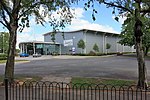Hymers College
Hymers College is a co-educational independent day school in Kingston upon Hull, located on the site of the old Botanical Gardens. It is one of the leading schools in the East Riding of Yorkshire and a member of the Headmasters' and Headmistresses' Conference.The school was founded following the death in 1887 of the Revd Dr John Hymers, Rector of Brandesburton, who left a substantial sum in his will for the founding of a school "for the training of intelligence in whatever social rank of life it may be found among the vast and varied population of the town and port of Hull". Construction of the buildings was completed in 1893, and the first pupils arrived in September of that year. The school, initially open only to boys, expanded to include girls incrementally from the 1970s, becoming fully co-educational in 1989.Presently, Hymers educates about 950 pupils aged 4–18 across the Pre-School, Junior and Senior Schools, with about 100 members of the teaching staff. The two major intakes of pupils are at age 4, into Year 1, age 7, into Year 3, and age 11, into Year 7. Additionally, some pupils enter at 14, into Year 10, and some at 16, into the Sixth Form. Old Hymerians include several prominent sportspeople, diplomats, academics and politicians, including the physicist Dr Edward Milne MBE FRS, who worked on the problem of the expanding universe, alongside Albert Einstein.
Excerpt from the Wikipedia article Hymers College (License: CC BY-SA 3.0, Authors).Hymers College
Hymers Avenue, Hull Avenues
Geographical coordinates (GPS) Address Phone number Website External links Nearby Places Show on map
Geographical coordinates (GPS)
| Latitude | Longitude |
|---|---|
| N 53.748401 ° | E -0.365094 ° |
Address
Hymers College
Hymers Avenue
HU3 1LW Hull, Avenues
England, United Kingdom
Open on Google Maps





